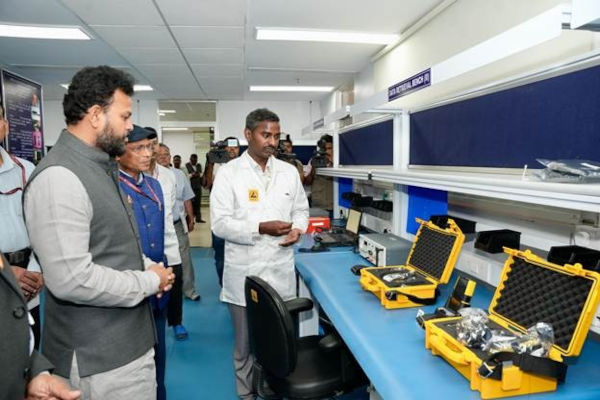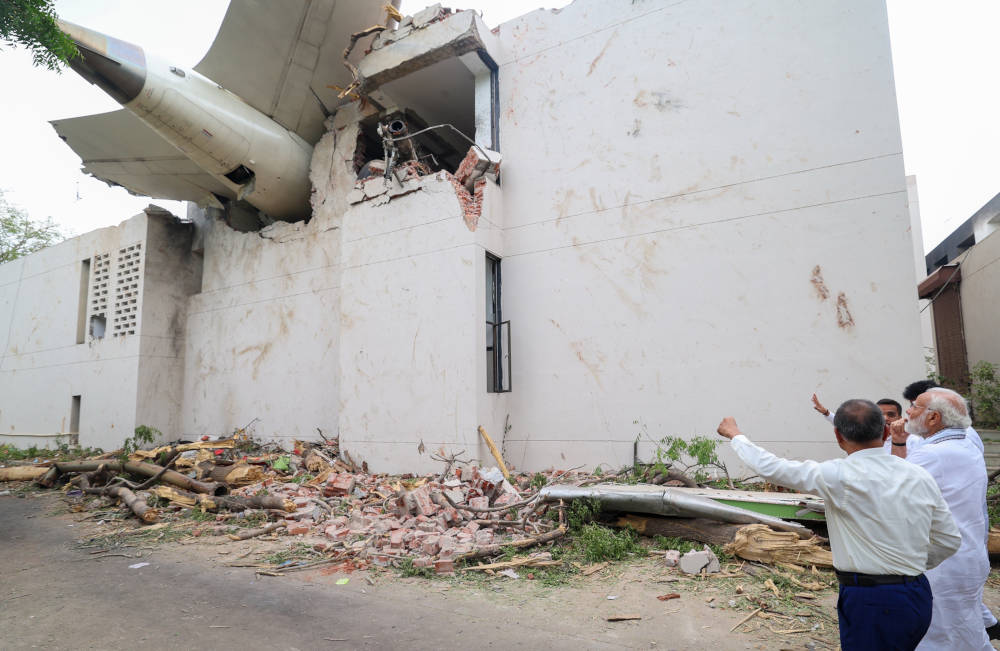[Prime Minister Narendra Modi visits the crash site of the AI-171 flight in Ahmedabad on June 13, 2025. (Source PIB)]
By Anmol Shrivastava and Indrajit Gupta
At 1:40 PM on June 12, Air India Flight AI 171 crashed shortly after takeoff from Ahmedabad, plunging into a residential area and erupting into flames. It was meant to be a routine flight to London. Instead, it became the world’s first fatal crash involving a Boeing 787 Dreamliner—one of the most advanced widebody jets ever built.
Within hours, India’s Aircraft Accident Investigation Bureau (AAIB) dispatched a five-member team led by Group Captain G.V.G. Yugandhar, the Bureau’s Director General. They were joined later that evening by forensic and medical experts.
By 6 PM, senior officials—including the Secretary of Civil Aviation, the DG of the Directorate General of Civil Aviation (DGCA), the Chairman of the Airports Authority of India, and Civil Aviation Minister Kinjarapu Ram Mohan Naidu—had arrived at the crash site. The fire had been brought largely under control, but the devastation was unmistakable.
That same evening, the investigation formally began. The mission is clear: not just to determine why a cutting-edge Dreamliner with a previously unblemished safety record fell from the sky—but to ensure it never happens again.
Can this investigation prevent history from repeating itself?
Given the aircraft involved and the questions it raises, this will likely be one of the most scrutinised aviation probes in decades.
The psychological toll is already immense. Graphic visuals from the crash site have flooded news channels and social media. Speculation over possible causes—fuel contamination, engine failure, pilot error—has only deepened public anxiety. Ironically, the DGCA’s announcement of enhanced safety checks, meant to reassure, has led to a wave of flight cancellations instead.
“The relentless stream of dramatic visuals—what we call the ‘availability heuristic’ in behavioural science—leaves a deep imprint on the minds of air travellers, fuelling a climate of fear,” said Biju Dominic, chief evangelist at Fractal and chairman of Final Mile. “Even though flying is statistically far safer than road travel, its unfamiliarity makes crises like these especially frightening.”
Public confidence won’t return until investigators uncover the root cause.
Typically, the AAIB promptly appoints an aviation safety expert to lead high-stakes probes. After the Air India Express Flight 1344 crash in Kozhikode in 2020, it took six days to constitute a five-member team, led by Captain SS Chahar. That investigation took nearly a year to complete.
A series of government clarifications and media leaks have revealed a familiar pattern of opacity
Now, two weeks after AI 171’s crash, there’s still no official confirmation on who will lead this probe. On Thursday, The Economic Times reported that Dhruva Rebapragada—a former regional safety director for Airbus, South Asia and ex-flight safety head at IndiGo—had been shortlisted. But the government has yet to confirm his appointment.
In fact, a series of government clarifications and media leaks have revealed a familiar pattern of opacity. Only after sustained pressure—from ET, The Hindu, and The New Indian Express—did the Ministry of Civil Aviation confirm that the black boxes had been recovered and their data extracted.
“The government usually operates on a need-to-know basis,” a veteran aviation journalist in Delhi told us. “But that doesn’t help when confidence is already shaken.”
[Ministry of Civil Aviation briefs the media on Ahmedabad air crash]
That same night, NTSB chair Jennifer Homendy, speaking to Bloomberg in Washington, called on Indian authorities to “swiftly” release the black box findings. “There’s been a lot of speculation,” she said. “It’s important for aviation safety that everybody know what the data shows. Otherwise, you run the risk of looking not transparent.”
In previous Indian crashes, such as Mangalore (2010) and Chakri Dadri (1996), the devices were decoded abroad. In 2020, after the Kozhikode crash, they were decoded at India’s DGCA laboratory—marking a shift from past practice. But India’s capability remained partial. Investigators still had to rely on the NTSB to convert raw data into usable engineering parameters, exposing lingering technical gaps. The final investigation report itself flagged that neither the DGCA nor India’s investigators possessed the full software suite needed for independent analysis. Based on a recommendation in the final report made by the Chahar committee, in April 2025, the government finally inaugurated a Rs 9 crore digital lab to decode black box data. The AI 171 crash will be the first real test of this upgraded system.
Initial reports suggested the flight data and cockpit voice recorders would be sent to the U.S. for analysis. But this time, the government quickly denied the ET report, perhaps wary of being seen as relinquishing control. Officials clarified that the data would be decoded in India, with technical support from the NTSB. On June 26, a Ministry of Civil Aviation press statement confirmed that black box extraction was completed at the new facility in Delhi and analysis was underway.

[Union Minister Ram Mohan Naidu inaugurates Digital Flight Data Recorder Lab at Aircraft Accident Investigation Bureau. Source: PIB]
A TOI report on Friday even claimed that the Prime Minister personally intervened to ensure the sensitive extraction was conducted domestically.
This defensiveness reflects a broader erosion of public trust—especially in Boeing.
The American manufacturer, already burdened by whistleblower allegations, production lapses, and the long shadow of the 737 MAX tragedies, is now facing renewed scrutiny of its Dreamliner fleet.
This is the first-ever fatal crash involving a 787. And possibly the first linked to a suspected dual engine failure or software malfunction.
During recent U.S. congressional testimony, former Boeing engineer Sam Salehpour alleged that shortcuts during assembly had compromised the 787’s structural integrity. He warned these flaws could become visible after 10-12 years of service.
An American Prospect magazine investigation cited Boeing insiders raising red flags about the specific batch of 787s supplied to India—including the ill-fated AI 171.
Another whistleblower, quality inspector John Barnett—who later died by suicide—had earlier warned of metal shavings and debris left inside the fuselage during assembly, especially near flight control wiring. He also reported missing or incorrect shims in the aircraft’s tail and body sections.
Though none of these issues have been definitively linked to a crash, they collectively highlight a dangerous pattern: structural compromises, assembly flaws, and a production culture that may have prioritised speed over safety. Boeing maintains that it has addressed the issues and continues to stand by the Dreamliner’s safety.
But the crash of AI 171 has thrown all of this into sharp relief.
For Boeing’s new CEO, Kelly Ortberg—appointed in August 2024—this is the first major crisis. His absence from the Paris Air Show—just four days after the crash—suggested a deliberate attempt by the company to avoid public scrutiny at the height of the crisis.
Adding to the turmoil: on Friday, an Ethiopian Airlines 787 suffered cabin depressurisation en route to Mumbai, prompting an emergency landing. Seven passengers were treated for symptoms. This followed an incident on June 23, when passengers and crew aboard an Air India 777 reported dizziness and nausea mid-flight from London to Mumbai.
The outcome of this investigation could reshape fleet strategies, procurement decisions, and even regulatory frameworks
Global carriers with large 787 fleets—like United, ANA, Qatar Airways, and Air India—are now on high alert. The outcome of this investigation could reshape fleet strategies, procurement decisions, and even regulatory frameworks.
The timing couldn’t be worse for Air India.
In the midst of a massive transformation under the Tata group, this crash threatens to derail months of progress. A reported 20% drop in bookings, slashed fares, and over 500 crew members calling in sick the day after the crash suggest deep internal turmoil. Fleet-wide audits and leadership changes are likely to follow.
For India’s aviation ecosystem, this may be its most important test.
After the Mangalore tragedy in 2010, the government established the AAIB in 2012 to ensure independent, globally aligned investigations. The Aircraft (Investigation of Accidents and Incidents) Rules, 2017, aligned India with the International Civil Aviation Organization (ICAO) norms—prioritising fact-finding over blame.
But this isn’t just a test of investigation protocols. It’s a test of India’s ambition to become a global aviation hub—an ambition built on bypassing Gulf transit hubs and offering direct connections to Europe and the U.S. via Indian carriers. That model now faces renewed scrutiny, and pressure is mounting to open Indian skies to more foreign competition.
That’s why this investigation matters.
Can India’s newly empowered aviation safety system uncover a clear, evidence-based explanation for what went wrong—and help ensure it never happens again?
Much depends on what unfolds in the weeks ahead. The world is watching. And for the families left behind—and the millions who continue to fly—the stakes couldn’t be higher.
Next: Part Two: Why the Media Frenzy Around the Air Crash Is Starting to Look Like Six Blind Men and the Elephant. Read it here


avi on Jul 29, 2025 12:49 a.m. said
This theory deserves a look https://www.youtube.com/watch?v=fl1kUudq7Tw